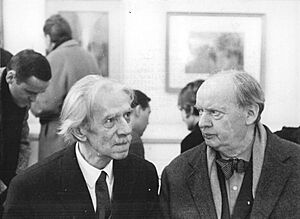Hans Scharoun facts for kids
Bernhard Hans Henry Scharoun (born September 20, 1893, died November 25, 1972) was a famous German architect. He is best known for creating the Berlin Philharmonic concert hall. He also designed the unique Schminke House in Löbau, Saxony. Scharoun was a key figure in what's called organic and expressionist architecture. This means his buildings often had flowing shapes and expressed strong feelings or ideas.
Contents
Hans Scharoun's Life
Early Years and Education (1893-1924)
Hans Scharoun was born in Bremen, Germany. Even as a teenager, he loved architecture. At 16, he drew his first building plans. When he was 18, he even entered a competition to redesign a church!
In 1912, he started studying architecture in Berlin. However, he did not finish his studies. When World War I began in 1914, he volunteered to serve. After the war, in 1919, he became a freelance architect in Wrocław (then called Breslau). He worked on many projects there. He also helped organize art shows, including the first exhibition for a group of artists called Die Brücke.
Growing as an Architect (1925-1932)
Scharoun became a professor at an art academy in Wrocław. He taught there until 1932. He joined a group of expressionist architects called the Glass Chain in 1919. Later, in 1926, he joined another group called Der Ring.
In 1927, Scharoun built a house in Stuttgart for a special exhibition. He also helped plan a large housing area in Berlin called Großsiedlung Siemensstadt. He was inspired by ideas that focused on how buildings should work for people. He believed that each building should have its own unique design based on its purpose. He especially cared about how living spaces were organized for communities.
During Difficult Times (1933-1945)
Many of Scharoun's friends left Germany during the Nazi era. But he chose to stay. During this time, he built only a few family homes. One famous example is the Schminke House in Löbau (1933). You can visit this house today!
Other houses he built during this period had to look "normal" from the outside. This was because of strict rules from the government. But inside, they still had Scharoun's unique and flowing designs. During World War II, he helped with rebuilding efforts after bomb damage. He also secretly drew many architectural ideas in watercolors. These drawings helped him prepare for a time when he could build freely again.
Post-War Work and Famous Buildings (1946-1972)
After World War II, Scharoun was chosen to help rebuild Berlin. He showed his ideas for the city's reconstruction in an exhibition. However, Berlin soon became divided, which made his work difficult.
In 1946, he became a professor of architecture at the Technical University of Berlin. After the war, he was finally able to build his ambitious and people-focused designs. Some of his most famous buildings include:
- The Romeo and Julia apartment towers in Stuttgart (1954–59).
- The Geschwister-Scholl-Gymnasium (a school) in Lünen (1956–62).
- The famous Berlin Philharmonic concert hall in Berlin (1956–63).
All these buildings show his unique approach. The school, for example, was designed like a small, friendly city for children. The apartment towers allowed people to arrange their living spaces flexibly. The Berlin Philharmonic is known worldwide as one of the best concert halls. Its design has the audience seating rising in terraces around the central stage, like a landscape.
Scharoun also designed the German Embassy in Brasília (1963–69). This is his only building outside of Germany.
Legacy After 1972
Some of Hans Scharoun's most important buildings were finished after he passed away in 1972. These include:
- The Deutsches Schiffahrtsmuseum (German Maritime Museum) in Bremerhaven.
- The theatre in Wolfsburg.
- The State Library in Berlin.
His office partner, Edgar Wisniewski, completed other projects. These included an extension to the Berlin Philharmonic. In the 1980s, the outside of the Philharmonic was covered with golden aluminum plates. Scharoun had wanted this look originally, but it was too expensive at the time. After Berlin was reunified, the area around the Philharmonic was rebuilt. This helped complete Scharoun's vision for that part of the city.
Awards and Prizes
Hans Scharoun received many honors for his work:
- 1954: Honorary Doctorate from the Technical University of Berlin
- 1954: Fritz Schumacher Prize
- 1955: Berlin Arts Prize
- 1959: Großes Bundesverdienstkreuz (Federal Grand Order of Merit)
- 1965: Honorary Doctorate from the University of Rome
- 1969: Honored citizen of Berlin
- 1970: Erasmus Prize
He was also the president of the Berlin Academy of Arts (West) from 1955 to 1968. He died in West Berlin at the age of 79.
Hans Scharoun's Work
-
An early work of Scharoun: Hostel in the WuWa-Werkbund exposition in Wrocław
-
Romeo & Julia, high-rise apartments, Stuttgart-Rot (1954–59)
-
Salute, high-rise apartments, Stuttgart-Fasanenhof (1961–63)
Selected Buildings
- A house called Die Wohnung (The Dwelling) for the Werkbund exhibition in Stuttgart (1927)
- Men's hostel for the Werkbund exhibition in Wrocław (1929)
- Apartments at Kaiserdamm, Berlin-Charlottenburg (1928/29)
- Apartments at Hohenzollerndamm, Berlin-Wilmersdorf (1929/30)
- Town planning and housing design at Großsiedlung Siemensstadt (1929–31)
- The Schminke house, Löbau/Sachsen (1933)
- The Baensch house, Berlin-Spandau (1935)
- The Hoffmeyer house, Bremerhaven (1935)
- The Moll house, Berlin-Grunewald (1936)
- The Mohrmann house, Berlin-Lichtenrade (1939)
- Romeo & Julia, high-rise apartments, Stuttgart-Zuffenhausen (1954–59)
- Charlottenburg-Nord, housing development, Berlin-Charlottenburg (1955–60)
- Girls School (now a comprehensive school), Lünen (1956–62)
- Berlin Philharmonic, Berlin-Tiergarten (1957–63)
- Salute, high-rise apartments, Stuttgart-Fasanenhof (1961–63)
- Main and primary school, Marl (designed in 1960, completed in 1971)
- Institutes of the faculty for architecture of the Technical University, Berlin (1962–70)
- Rauher Kapf, residential district Böblingen (1965)
- Orplid, high-rise apartments, Böblingen (1971)
- Embassy building for the Federal Republic of Germany, Brasília (1964–71)
- City Theatre, Wolfsburg (1965–73)
- Deutsches Schiffahrtsmuseum (German Maritime Museum), Bremerhaven (1970–75)
- State Library, Prussian Cultural Heritage Foundation, Berlin-Tiergarten (1964–79)
Images for kids
See also
 In Spanish: Hans Scharoun para niños
In Spanish: Hans Scharoun para niños











